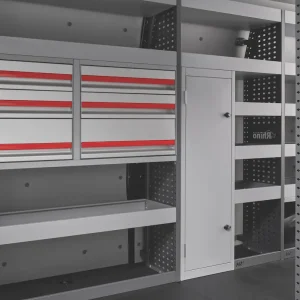The National Association of Motor Auctions (NAMA) is gearing up to introduce condition-based grading for used vans, similar to the existing car grading scheme that was launched in 2012 and widely used across the remarketing industry.
Currently planned for early 2024, LCV grading will use the same methodology as the car equivalent, adapted for second-hand vans. It will rank from one, as the best condition, to five, the worst – a lower grade ‘U’ also exists for heavily damaged vehicles.
NAMA says vehicle grading is designed to “facilitate the buying and selling process… so that the condition of the vehicle is better understood by both parties. With a universal understanding of a vehicle’s condition, it is now possible for both parties to anticipate a more accurate market sale price.”
The LCV scheme has long been in the works and has been extensively discussed by the remarketing industry since before the advent of car grading. Paul Hill, NAMA advisor, tells What Van?: “When we initially launched [grading for] cars, we were talking to lots of customers… around the need for commercial vehicle grading. At the time, there was the feeling that, actually, you don’t need any sort of grading scheme for commercial vehicles.
“We started the discussion again in probably 2018–19, and… it was starting to gain more in terms of a desire and momentum within the industry. But then, of course, lockdowns, Covid and everything else came.”
According to Hill, there has been “a change in the market”. Now, NAMA is pressing ahead with the scheme to address the increasing number of older used vans in poorer condition. It held a roadshow and roundtable event at the Cox Automotive Collaboration Centre at Bruntingthorpe, Leicestershire, on 17–18 July in which used LCV buyers and sellers aired their views on grading. They also examined five used vehicles that represented the scheme’s proposed condition categories.
The organisation said it would use the feedback from buyers and vendors to further develop the scheme, which will then be trialled by several auction companies. It is planning another round table event in November to share its analysis and present what it says will be the final LCV grading scheme.
“When you start to walk around five different vehicles in five different grade categories, you then start to open up the subjective debate that says, ‘well, I think that’s actually grade three, and somebody else thinks it should be a grade four,” says Hill.
“When you talk through the reasons why, what’s causing it to be that particular grade, then, all of a sudden, everybody understands, and they’re generally accepting of it.”
According to Hill, the LCV grading scheme is close to completion and will adopt the same general format as its car equivalent. However, further development is ongoing to account for aspects of condition that are unique to used LCVs, chief among them being load bays.
“The one big thing is the loading area, what we often refer to as the yellow zone on a commercial vehicle,” says Hill. “That is being treated in a different way to cars… There is more of an acceptance of a degree of wear and tear, so if a vehicle were deemed to be within wear and tear standards, for instance, that would not necessarily have a detrimental effect on its grade.”
Those standards are “not crystallised,” according to Hill, and are among the areas NAMA is still working on.
One of the difficulties facing van grading is the variety of vehicle bodies and applications, which differs substantially from the car market and complicates the assessment process.
Philip Nothard, insight director at Cox Automotive, says this is one of the reasons why a van grading scheme has taken so long to establish.
“A car has a shell, four wheels, a bonnet and a boot,” he explains. “In the most the basics of terms, it [appraisal] is fairly standard from one car to another to another.
“The challenge is the complexity of a commercial vehicle… 90% of the time, a commercial vehicle is for an end user. It’s a work tool, and there are elements of a commercial vehicle that are more relevant to the user than the condition. You get a vehicle that’s ply-lined or it is not ply-lined. Is there a bulkhead or not? Has it been a BT van? What do you appraise on a tipper truck?
“How many appraisal templates do you have to cover the complexity of the commercial vehicle marketplace? Let’s take it from digital to paper: How many sheets of paper do you have to do an appraisal? All the various types – not derivatives – the types of commercial vehicles. That’s the bit that they’ve got to get around.”
Grading is conducted by NAMA-trained inspectors who examine the vehicle and make a note of its condition. As Hill explains, assessors are responsible only for the recording aspect because the grade itself is concluded by NAMA’s software.
“The common misconception is that a vehicle inspector determines what grade a vehicle is, which is absolutely not true,” he defends.
“A vehicle inspector is highly unlikely to know what grade a vehicle is, even when he or she has completed the inspection… literally, all they’re doing is recording the damage – ‘I’ve got a 30mm scratch there and a 20mm dent there’ or whatever it may be.”
Inspectors will then punch their findings into the auction company’s software, which generates a grade based on NAMA’s data and algorithms.
“In round numbers, there are about 10,000 different matrix components,” says Hill. “For want of a better term, all of those get put into a machine, which says, ‘right, this is the grade for that vehicle,’ so everything’s predetermined. There are some really minor elements that on their own wouldn’t affect a grade, but if you had 10 of them, then they potentially would. There are also some fairly major elements – structural parts of the roof panel, for instance – that would affect the grade right from the outset.”
NAMA claims the scheme is applied to more than 90% of cars sold at auction, which is said to have equated to more than 10 million units since its inception. The scheme received the King’s Award for Enterprise in April this year.
Remarketing companies have previously told What Van? that they sometimes employ ‘tactical refurbishment’ to prepare vehicles to a particular grade to boost their value and improve their chances of a first-time sale at auction. This might involve, for example, relatively low-level body repairs to bring a vehicle from a grade four to a grade three, which would increase its appeal to buyers and its potential sale price for a nominal sum.
Despite its accolades and now industry-standard status, NAMA’s car grading scheme has come under fire in the past, with some claiming the grades can be inconsistent and unreflective of the vehicle’s condition.
Speaking to What Van?’s sister publication Business Car on condition of anonymity in 2019, a senior auction company manager said: “We still get feedback that a grade A (one) in one site can be a grade B (two) somewhere else – and it could even be a grade C (three). So, the application of it is still a problem, but the need to have it is becoming more prevalent.”
Car grading has been refined over the years and training has increased for those applying it. Though not without its flaws, remarketing specialists generally acknowledge that an industry-wide programme is superior to an alternative whereby individual auction companies are left to create their own standards. Nonetheless, it continues to be divisive among buyers and sellers alike.
Nothard believes the same is likely to apply to van grading and, as with cars, some teething trouble is to be expected, but the scheme has been too long in the works to wait much longer.
“Car grading has been going for 11 years. It’s had various changes and developments, and still today comes under scrutiny in terms of its accuracy and subjectivity. You’re going to get that for commercial vehicles and you’re probably going to get more of it. But… it’s taken 15 years’ worth of discussion, debate and shutdowns and we’ve still not done it.
“How long do you take to try and perfect something? Do you actually not do it, or do you do something and work through it once you’ve done it? I think the decision has to be that you work through it.”





